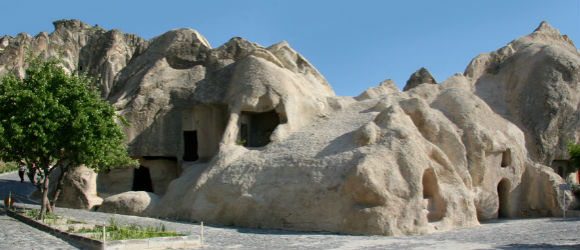Chapel Of St. Basil is situated at the entrance to the Goreme Open Air Musuem. Graves are to be found in the columned narthex area. The nave is transversely rectangular and barrel vaulted, and has three apses situated on the left, long side of the rectangular nave. The church dates back to the 11th century. Scenes: On the main apse is a portrait of Jesus, and next to this is a portrait of Mary and Baby Jesus. On the north wall is a picture of St. Theodore, while St. George and the Dragon are featured on the south wall. The paintings of St. Demetrius and two female saints can also be seen.”
Saint Basil the Great (c. 330 – 379) is one of the most important influences on both Byzantine and Western monasticism. Before forming his own monastic community, he visited Egypt, Mesopotamia, Palestine and Syria, observing the monastic life and learning both from the positive and negative examples he encountered. He later composed his Asketikon for the members of the monastery he founded about the year 356 on the banks of the Iris river in Cappadocia. St Basil’s work entailed two sets of monastic regulations: the Lesser Asketikon and the Greater Asketikon. Correspondence exists between him and St. Gregory Nazianzen which gives further insight into the type of monastic life he established.
On the main apse is a portrait of Jesus, and next to this is a portrait of Mary and baby Jesus. On the north wall is picture of St.Theodore, while St.George and the dragon are featured on the south wall. The paintings of St. Demetrius and two female saints can also be seen.
Chapel of St. Basil,




St. Basil the Great
Saint Basil the Great (c. 330 – 379) is one of the most important influences on both Byzantine and Western monasticism. Before forming his own monastic community, he visited Egypt, Mesopotamia, Palestine and Syria, observing the monastic life and learning both from the positive and negative examples he encountered. He later composed his Asketikon for the members of the monastery he founded about the year 356 on the banks of the Iris river in Cappadocia. St Basil’s work entailed two sets of monastic regulations: the Lesser Asketikon and the Greater Asketikon. Correspondence exists between him and St. Gregory Nazianzen which gives further insight into the type of monastic life he established.